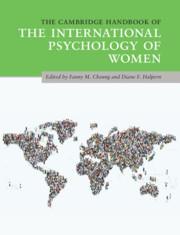Book contents
- The Cambridge Handbook of the International Psychology of Women
- The Cambridge Handbook of the International Psychology of Women
- Copyright page
- Dedication
- Contents
- Figures
- Tables
- Contributors
- Acknowledgments
- Section 1 The Underpinnings of Sex and Gender and How to Study Them
- Section 2 Developmental Perspectives of the International Psychology of Women
- Section 3 Cognitive and Social Factors
- Section 4 Work and Family Issues
- Section 5 Inequality and Social Justice
- Section 6 Health and Well-Being
- 31 Happiness across Cultures and Genders
- 32 Women under Pressure
- 33 Gender and Women’s Sexual and Reproductive Health
- 34 Physical Health
- 35 Women and Suicidal Behavior
- 36 Sex and Gender in Psychopathology
- 37 Women and Psychotherapy
- Epilogue Some Final Thoughts and Take-Home Messages
- Index
- References
32 - Women under Pressure
The Intersection of Stress and Trauma with Aspects of Gender
from Section 6 - Health and Well-Being
Published online by Cambridge University Press: 20 July 2020
- The Cambridge Handbook of the International Psychology of Women
- The Cambridge Handbook of the International Psychology of Women
- Copyright page
- Dedication
- Contents
- Figures
- Tables
- Contributors
- Acknowledgments
- Section 1 The Underpinnings of Sex and Gender and How to Study Them
- Section 2 Developmental Perspectives of the International Psychology of Women
- Section 3 Cognitive and Social Factors
- Section 4 Work and Family Issues
- Section 5 Inequality and Social Justice
- Section 6 Health and Well-Being
- 31 Happiness across Cultures and Genders
- 32 Women under Pressure
- 33 Gender and Women’s Sexual and Reproductive Health
- 34 Physical Health
- 35 Women and Suicidal Behavior
- 36 Sex and Gender in Psychopathology
- 37 Women and Psychotherapy
- Epilogue Some Final Thoughts and Take-Home Messages
- Index
- References
Summary
In this chapter we discuss a number of aspects related to how women experience and engage with life stressors, including traumatic events. We seek to answer some of the questions concerning whether, how, and why women may experience stress differently from men.
- Type
- Chapter
- Information
- The Cambridge Handbook of the International Psychology of Women , pp. 459 - 471Publisher: Cambridge University PressPrint publication year: 2020
References
Suggested Readings

Gillian Eagle is a clinical psychologist and Professor in the Department of Psychology at the University of the Witwatersrand, Johannesburg. She lectures primarily in the field of clinical psychology. Her key research interest is the field of traumatic stress studies, with a particular focus on how traumatic stress responses are shaped by aspects of social identity and social context. She also has a strong interest in gender, violence perpetration, and masculinity. With Debra Kaminer she co-authored the book Traumatic stress in South Africa (2010). Eagle was born in Johannesburg and grew up in Pietermaritzburg, where she went through college and graduate school.

Susan Ayers was born in the USA and grew up in the UK. She is currently a psychologist and Professor at City University of London, in the Centre for Maternal and Child Health Research. Her research examines women’s perinatal mental health, in particular birth trauma, posttraumatic stress disorder, and high-risk groups such as parents who have preterm or stillborn babies. She is a founder of the International Network for Perinatal PTSD and author of Psychology for medicine (2010), and the Cambridge handbook of psychology, health and medicine (1997).

Charity Mkone is a registered clinical psychologist and Lecturer in the Department of Psychology at the University of the Witwatersrand, Johannesburg. She lectures primarily in the field of clinical interventions and community clinical practice. She has a particular interest in the intersection of gender, race, and class in shaping aspects of identity. She is currently completing research into the relationship between African fathers and their daughters.

Mapule Moroke is a counseling psychologist and Lecturer in the Department of Psychology at the University of the Witwatersrand, Johannesburg. She lectures primarily on social and community psychology. Her key research interests lie in the field of critical race, gender, class, and intersectionality experience of young adults and adolescents in contemporary South Africa. She also has a strong interest in violence, fear of crime, and masculinity.



